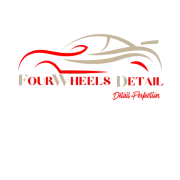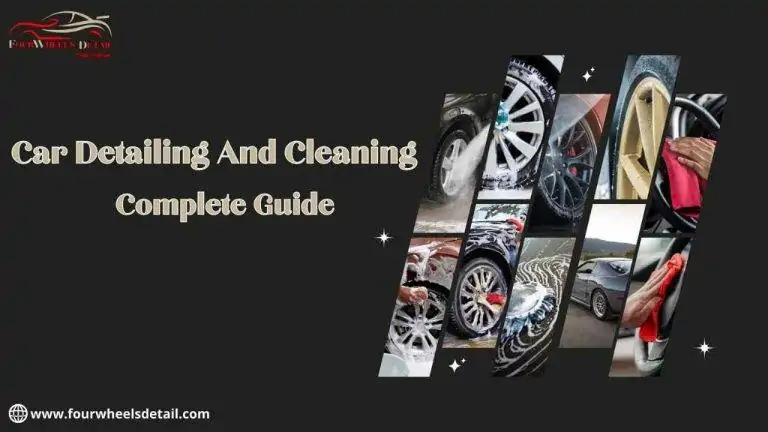The global car detailing and cleaning market was valued at around $33.27 billion in 2022, and it is expected to grow to $50.86 billion by 2030 at a compound annual growth rate. Car detailing and cleaning are essential for maintaining your vehicle’s appearance, performance, and value. By keeping your car clean and polished, you enhance its longevity, improve resale value. Don’t miss out on these must-know car detailing and cleaning advanced products, tools and car exterior and interior cleaning step-by-step guide given below:
Table of Contents
ToggleWhat is Car Detailing and Cleaning?
Car detailing refers to the professional process of thoroughly cleaning, restoring, and finishing a vehicle, both inside and out, to achieve a high level of cleanliness and polish. It goes far beyond a regular car wash, which typically focuses on the surface-level cleaning of the exterior and interior. Detailing includes specialized techniques and tools to remove tough contaminants, restore faded paint, and protect the vehicle’s interior and exterior surfaces from future damage.
Difference Between Car Washing and Car Detailing
Car Washing
Car washing is a quick process that typically involves cleaning the exterior with soap and water, and a light vacuum of the interior. While it removes dirt and grime from the surface, it doesn’t address deeper issues like oxidation, paint swirl marks, or contamination embedded in the vehicle’s surfaces.
Car Detailing
Car detailing, on the other hand, is a more intricate process that involves restoring the vehicle’s paint and interior to its original condition. It includes decontaminating the paint, treating the interior with specialized cleaners and conditioners, and adding protective layers like wax, sealants, or ceramic coatings. Detailing aims not just for cleanliness but also for long-term protection and preservation of the vehicle.
Benefits of Regular Car Detailing and Cleaning
- Preserves Resale Value: Regular detailing helps maintain the car’s condition, which can significantly increase its resale value. A well-maintained vehicle looks and feels like new, which appeals to potential buyers.
- Enhances Appearance and Shine: Detailing brings out the full beauty of your car’s paintwork, making it look glossy and sleek. Polishing and waxing can restore the depth of color and shine.
- Superior Protection Against Elements: The sun’s UV rays, rain, dirt, and bird droppings can degrade your car’s exterior over time. Detailing adds layers of protection, such as wax or ceramic coatings, which act as a barrier against these harmful elements.
- Improved Hygiene and Interior Freshness: The interior of a car can accumulate dirt, bacteria, and allergens over time. Deep cleaning through detailing ensures the air quality inside your vehicle is clean, and all surfaces are free from germs and dirt.
DIY vs. Professional Detailing Services
When deciding whether to detail your car yourself or hire a professional, consider the following:
- Cost: DIY car detailing is usually cheaper since you only need to invest in tools and products. However, professional detailing services, while more expensive, bring years of expertise and specialized equipment.
- Time: Detailing a car can take several hours, depending on the level of thoroughness. A professional can do it more quickly with better results.
- Expertise: Professional detailers are trained to work on all types of cars and surfaces without causing damage. DIY efforts might lack the precision needed for delicate tasks like paint correction or applying ceramic coatings.
II. Essential Car Detailing and Cleaning Supplies
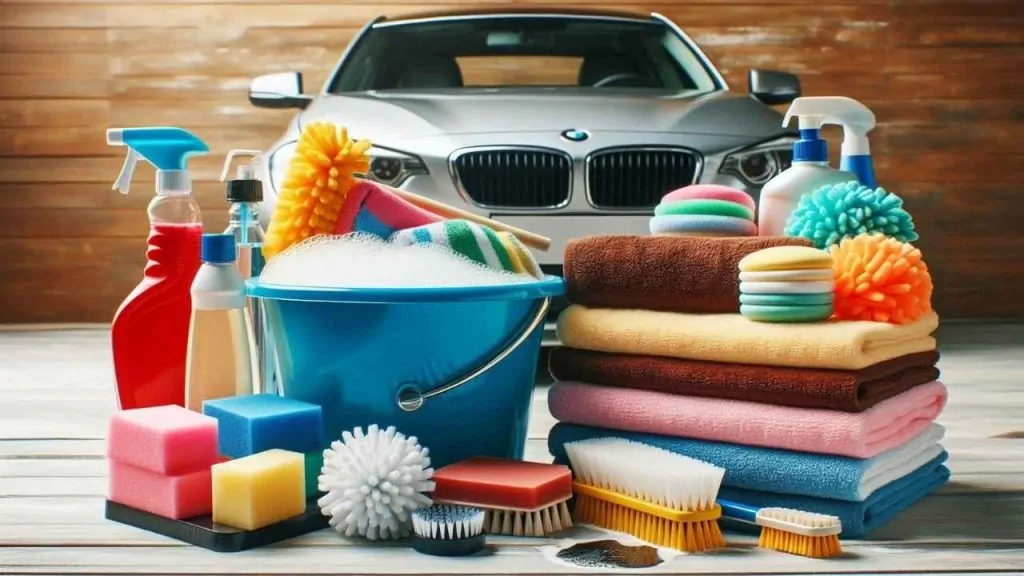
A. Exterior Cleaning Equipment & Tools
Washing Supplies:
- Two-Bucket Wash Method: One of the safest techniques to avoid scratching your car’s paint. Use one bucket for the soapy water and another for rinsing your wash mitt. This prevents dirt particles from being reintroduced onto the paint during the wash process.
- Pressure Washer: A high-powered tool that removes loose dirt and debris before hand washing. Be careful not to spray too close to the paint, especially on delicate areas like trim or emblems, as high pressure can cause damage.
- Foam Cannon: Attaches to a pressure washer and applies a thick layer of foam to pre-soak the car, loosening dirt and grime before the actual wash. This helps minimize the need for scrubbing, which reduces the chance of swirl marks.
- Wash Mitts: Microfiber mitts are recommended because they’re soft and reduce the risk of scratching the paint. Avoid using sponges, as they tend to trap dirt and cause swirl marks on the surface.
- Wash Brushes: Use soft-bristle brushes for scrubbing wheels, emblems, and trim. Different types of brushes are designed for specific areas, like lug nuts or intricate grills.
- Microfiber Drying Towels: Use large microfiber towels, preferably waffle weave, for drying the car. These are highly absorbent and gentle on the paint, reducing the risk of scratching.
- Leaf Blower: A touchless way to dry the car. It helps blow off water from crevices where towels might miss, like around mirrors, emblems, and grills.
B. Interior Cleaning Equipment & Tools
- Vacuum Cleaner: Use a vacuum with multiple attachments for cleaning the interior. The crevice tool is perfect for tight spaces like between seats, while the upholstery brush is gentle on fabrics.
- Detailing Brushes: Fine-bristle brushes designed for cleaning intricate areas like air vents, cup holders, and dashboard buttons. These brushes can reach places a microfiber cloth can’t.
- Steam Cleaner: A versatile tool that deep cleans and sanitizes fabrics, carpets, and hard-to-reach areas like under seats or around trim without using harsh chemicals.
- Microfiber Cloths: Use different microfiber cloths for different surfaces, like one for cleaning the dashboard and another for windows. This prevents cross-contamination of dirt and grease.
III. Recommended Car Detailing and Cleaning Products
A. Exterior Products
- Car Wash Soap: Always use a pH-neutral car wash soap, which is gentle on the paint and won’t strip away wax or sealants. High-foaming formulas are ideal for lubricating the surface, making it easier to remove dirt.
- Wheel Cleaner: Formulated specifically for removing brake dust and road grime, which can be acidic and damage the wheels if not cleaned regularly. Use a non-acidic cleaner for routine washing to avoid corrosion.
- Tire Dressing: Tires can be treated with either a matte or glossy finish. Water-based tire dressings are recommended for a more natural look and longer-lasting shine. They also prevent cracking from UV exposure.
- Clay Bar: This removes embedded contaminants like tar, tree sap, and industrial fallout that regular washing can’t eliminate. The clay bar treatment leaves the paint feeling smooth, ready for polishing and waxing.
- Polishes and Waxes: Polishing removes fine scratches and oxidation, restoring the original shine of the paint. Waxes (either carnauba or synthetic) add a protective layer that repels water, dirt, and UV rays.
- Ceramic Coatings: These provide longer-lasting protection compared to wax. Ceramic coatings bond with the paint, creating a durable layer that resists environmental contaminants like bird droppings, UV rays, and tree sap for up to a year or more.
- Glass Cleaner: For streak-free windows, use an ammonia-free cleaner. Ammonia can damage window tint and leave residues on interior surfaces.
B. Interior Products
- Leather Cleaner and Conditioner: Leather seats require regular cleaning and conditioning to prevent cracking and fading. A pH-balanced leather cleaner removes dirt, while a conditioner keeps the leather soft and supple.
- Fabric Upholstery Cleaner: Designed for cloth seats, this cleaner lifts stains and eliminates odors without leaving behind a sticky residue. It’s essential for deep cleaning the seats and carpets.
- Dashboard and Plastic Protectants: Protectants help prevent cracking and fading from UV exposure. Choose a low-gloss, non-greasy formula to avoid a slippery finish.
- Enzyme-Based Stain Remover: Excellent for breaking down organic stains like food or drink spills. Enzyme cleaners are more effective at targeting protein-based stains, ensuring they don’t leave lasting marks.
- Odor Neutralizers: Use these products to eliminate persistent odors like smoke or mildew. They work by neutralizing the particles that cause bad smells rather than just masking them.
Advanced Products and Tools for Car Detailing:
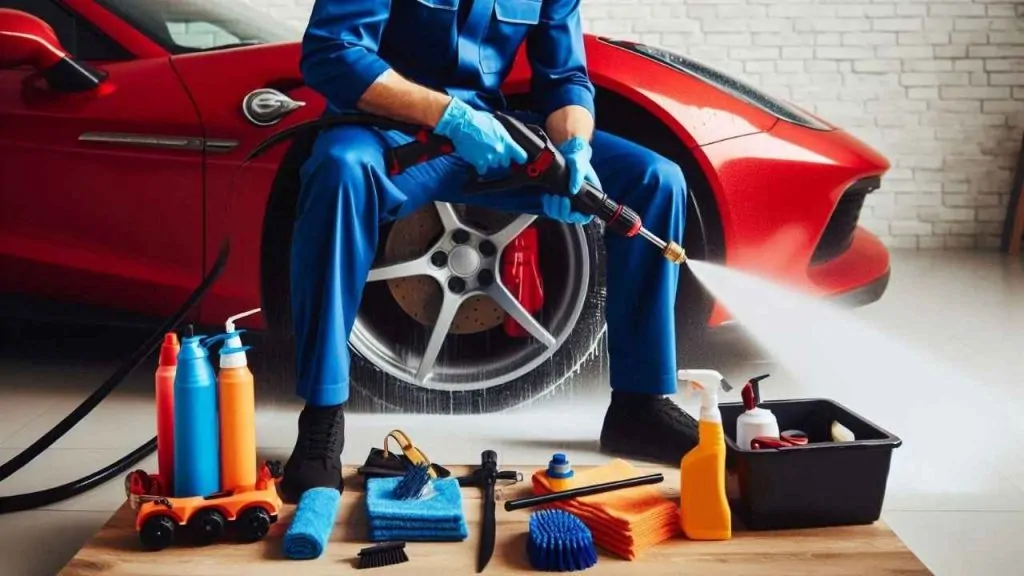
1. Paint Depth Gauge
- Purpose: A paint depth gauge measures the thickness of the paint on a vehicle, helping you understand how much paint is left before doing any corrective work like polishing. This is especially useful when performing paint correction with abrasive compounds.
2. Detailing Light (Inspection Light)
- Purpose: These lights are designed to reveal imperfections, swirl marks, or scratches that might not be visible under regular lighting. LED lights specifically designed for detailing offer the best clarity.
3. Iron Remover
- Purpose: Iron fallout (tiny metallic particles) can bond to your car’s paint. An iron remover chemically dissolves these contaminants without scrubbing, which helps prep the paint for claying and polishing.
4. All-Purpose Cleaner (APC)
- Purpose: APCs can be used for various cleaning tasks, such as cleaning door jambs, engine bays, and plastic trim. It’s a versatile cleaner that works on many surfaces, making it a must-have for detailers.
5. Detailing Clay Lubricant
- Purpose: A clay lubricant is necessary to ensure the clay bar glides smoothly over the car’s surface without marring the paint. While some detailers use diluted car wash soap, a specialized lubricant offers better protection.
6. Polishing Pads (Various Types)
- Purpose: When using a polisher, different types of polishing pads are necessary for different tasks. For instance, foam pads are softer and ideal for applying waxes, while microfiber or wool pads are better for paint correction and removing oxidation.
7. Orbital or Dual-Action Polisher
- Purpose: If you’re doing more advanced detailing, a dual-action polisher is essential for applying polishes and compounds to remove paint imperfections without the risk of damaging the paint like a rotary polisher might.
8. Wheel Sealant
- Purpose: After cleaning and polishing your wheels, applying a wheel sealant offers protection against brake dust and road grime. It creates a hydrophobic barrier, making it easier to clean the wheels during the next wash.
9. Trim Restorer
- Purpose: Over time, plastic trims can fade due to UV exposure. A trim restorer helps revive the color of black plastic trim, making it look new again. It also protects the trim from future fading.
10. Tire Brushes with Different Hardness Levels
- Purpose: While softer brushes are used for washing the body, having brushes with different hardness levels is necessary for cleaning the tires. A stiffer brush can help remove embedded dirt from tire sidewalls.
11. Microfiber Applicator Pads
- Purpose: These small, handheld pads are ideal for applying wax, sealant, or dressing to specific areas like tires, trim, or small sections of the car. They allow for more precise application.
12. Carpet Extractor or Wet Vacuum
- Purpose: For deep-cleaning car carpets and upholstery, a carpet extractor or wet vacuum is incredibly useful. It uses water and suction to remove embedded dirt, stains, and odors from the fabric.
13. Glass Polishing Kit
- Purpose: For cars with heavily scratched or hazy windows, a glass polishing kit can help restore clarity. These kits usually include a specific compound and pad for polishing glass surfaces.
14. Paint Protection Film (PPF) Squeegee
- Purpose: If you’re applying paint protection film (PPF) to prevent chips and scratches, a squeegee is necessary for applying it smoothly without trapping air bubbles.
15. Foam Gun
- Purpose: Similar to a foam cannon but works with a garden hose instead of a pressure washer. It helps apply thick foam that clings to the car’s surface, loosening dirt and grime before a contact wash.
16. Quick Detailer Spray
- Purpose: A quick detailer spray is a versatile product that adds a layer of shine and protection between washes. It can also help remove light dust and fingerprints without needing a full wash.
17. Water Spot Remover
- Purpose: Water spots can form when minerals from water droplets are left to dry on the car’s surface. A specialized water spot remover dissolves these minerals without damaging the paint or glass.
18. Interior Trim Cleaner and Protectant
- Purpose: Interior trim (like plastic, rubber, and vinyl) needs specific care. This cleaner removes dust and stains, while the protectant helps prevent cracking and fading from UV exposure.
19. Odor Bomb (Ozone Generator)
- Purpose: For cars with stubborn odors, an ozone generator or “odor bomb” can help eliminate smells at the molecular level, including those caused by smoke, food, or pets.
20. Leather Repair Kit
- Purpose: If your leather seats have small scratches or cracks, a leather repair kit can help restore them. These kits often come with a filler, dye, and protective coating to match the leather’s color.
21. Plastic Razor Blades
- Purpose: Great for removing stickers, decals, or bird droppings from your car without scratching the paint or glass. The plastic blades are gentle on the surface.
22. Headlight Coating
- Purpose: After restoring headlights, applying a headlight coating will prevent them from oxidizing again and keep them clear for a longer time.
23. Wheel Woolies (Soft Wheel Brushes)
- Purpose: These are soft, long-handled brushes that can clean deep into the barrels of your wheels, where brake dust tends to accumulate, without scratching the surface.
24. Engine Degreaser
- Purpose: For cleaning under the hood, an engine degreaser can break down oil and grease buildup on the engine block, hoses, and other components. Be sure to use one that’s safe for automotive parts.
25. Air Compressor
- Purpose: An air compressor is useful for blowing dust and debris out of tight areas like air vents, crevices, and between seat cushions. It can also be used to dry hard-to-reach spots after washing.
26. Wheel Wax or Coating
- Purpose: After cleaning your wheels, applying a wheel-specific wax or ceramic coating can protect them from brake dust, road salt, and other contaminants.
27. Brush for Convertible Tops
- Purpose: If you have a convertible with a fabric top, a special brush and fabric cleaner are needed to avoid damaging the material while cleaning it thoroughly.
28. Swirl Finder Light
- Purpose: This tool helps detect swirl marks, scratches, and imperfections in the paint before or after polishing, ensuring that no spots are missed.
29. Polish Residue Remover
- Purpose: After polishing, some residue might remain on the surface. A polish residue remover ensures that the surface is completely clean before applying a wax or sealant.
30. Water Deionizer
- Purpose: Deionized water prevents water spots from forming when rinsing the car. It’s especially useful if you live in an area with hard water.
31. Snow Foam Lance
- Purpose: A snow foam lance attaches to your pressure washer and creates a thick foam that clings to the car’s surface, making it easier to remove dirt and grime.
32. Grit Guard Washboard
- Purpose: An attachment to the bucket grit guard, the washboard allows you to rub your mitt or brush against it to dislodge dirt, keeping the cleaning water even cleaner.
33. Tire Cleaning Pads
- Purpose: These pads are designed specifically for applying tire cleaners and tire dressing products evenly across the tire surface, ensuring a smooth, professional finish.
34. Detailing Swabs (Foam or Cotton)
- Purpose: Useful for cleaning tight spaces like air vents, buttons, seams in seats, and around badges and emblems. They help reach areas where larger brushes cannot fit.
36. Iron Remover
- Purpose: This product helps remove iron particles (from brake dust or industrial fallout) embedded in the paint or wheels. It chemically reacts with the iron, dissolving it for easier removal.
37. Paint Depth Gauge
- Purpose: A tool used to measure the thickness of the car’s paint, which helps determine whether it’s safe to polish or if the paint is too thin to handle aggressive correction.
38. Foam Pads (Polishing, Cutting, and Finishing Pads)
- Purpose: Foam pads of different densities are used with a polisher to correct imperfections in the paint. Cutting pads are for heavy correction, polishing pads for mild imperfections, and finishing pads for applying wax or sealant.
39. Detailing Clay Mitt or Clay Towel
- Purpose: An alternative to the traditional clay bar, these products remove surface contaminants more quickly and can be used on a larger surface area with ease.
40. Microfiber Wash Mop (with Extendable Handle)
- Purpose: For larger vehicles like SUVs or trucks, a microfiber wash mop makes it easier to reach the roof and other high areas without needing a ladder.
41. Detailing Creeper Seat
- Purpose: A mobile seat with storage that allows you to sit comfortably while working on lower parts of the vehicle (like wheels or bumpers), reducing strain and improving mobility.
42. Polishing Compound
- Purpose: Used to remove oxidation, heavy swirl marks, and scratches from the paint surface. It’s a more aggressive product than standard polish but essential for paint correction.
43. Ceramic Coating Applicator Pads
- Purpose: These pads are used to apply ceramic coatings evenly across the car’s surface, providing long-lasting protection against the elements, dirt, and minor scratches.
44. Wheel Woolies (Smaller Sizes for Calipers and Tight Areas)
- Purpose: These smaller-sized woolies help clean intricate areas of the wheels, like the brake calipers and lug nut holes, where traditional brushes may not reach.
45. Wheel Detailing Sticks
- Purpose: Thin and flexible sticks with microfiber or foam ends used to clean inside wheel spokes and other hard-to-reach areas on the wheels.
46. Headlight Sealant
- Purpose: After restoring headlights, a headlight sealant provides long-term protection from UV damage and prevents them from yellowing or becoming hazy again.
47. Rotary Polisher
- Purpose: A more advanced machine polisher that offers more power than dual-action (DA) polishers. It’s used by professionals for heavy paint correction, but care is needed to avoid damaging the paint.
48. Leather Repair Balm
- Purpose: Used to fix minor scratches, cracks, and discoloration in leather seats or other leather interior components. It restores the color and smoothness of the leather surface.
49. Paintless Dent Repair Tools
- Purpose: For removing minor dents without affecting the paint, these tools are useful for addressing small dings and imperfections on the body of the car.
50. Car Dryer
- Purpose: A dedicated car dryer (like a filtered blow dryer) that blows air to dry the car without touching the surface, preventing water spots and minimizing the risk of scratching.
51. Buffing Pads for Metal and Chrome
- Purpose: Designed specifically for metal and chrome surfaces, these pads help bring a high shine to chrome bumpers, exhaust tips, or any other metal elements on the car.
52. Trim Restoration Product
- Purpose: Used to restore faded plastic trim back to its original color and shine. This product often protects against future fading caused by UV exposure.
53. Fabric Protector (Scotchgard or Similar)
- Purpose: After cleaning fabric seats and carpets, a fabric protector adds a protective layer to repel liquids and stains, making future cleaning easier.
54. Tar Remover
- Purpose: Specialized for removing stubborn tar spots that can accumulate on the lower parts of the car after driving on newly paved roads.
55. Interior Dressing (Matte or Satin Finish)
- Purpose: Adds a protective layer to the dashboard, door panels, and other plastic surfaces while leaving a non-greasy, matte or satin finish depending on the desired look.
56. Ozone Generator
- Purpose: Removes strong odors like smoke, pet smells, or mildew from the car’s interior by generating ozone, which breaks down odor-causing particles.
57. Infrared Curing Lamp
- Purpose: Used to accelerate the curing process of ceramic coatings or paint correction products, ensuring they bond properly and last longer.
58. Carpet Extractor
- Purpose: A machine that sprays cleaning solution and extracts dirt and moisture from deep within carpets and upholstery, offering a more thorough clean than a standard vacuum.
59. Engine Bay Detailing Kit
- Purpose: Includes brushes, degreasers, and protectants specifically for cleaning and detailing the engine bay, making it look like new without damaging sensitive components.
60. Adhesive Remover
- Purpose: Removes sticky residues from decals, stickers, and other adhesives without harming the paint or trim.
61. Steam Gun
- Purpose: A more concentrated steam cleaner used for targeted areas, such as hard-to-reach spots, crevices, or heavily soiled surfaces in the interior.
62. Squeegee for Window Tinting
- Purpose: A flexible squeegee used during the application of window tints to remove bubbles and ensure a smooth finish.
63. Microfiber Polishing Pads
- Purpose: Specifically designed for use with machine polishers to deliver better results when correcting the paint, offering more cut than foam pads while still being gentle on the surface.
64. Plastic and Trim Restorer
- Purpose: Restores faded plastic and rubber parts on the exterior of the vehicle, making them look new again while providing UV protection.
65. Water Deionizer (for Spot-Free Rinsing)
- Purpose: Removes minerals from the water, ensuring a spot-free rinse and preventing water spots from forming when washing the car.
66. Paint Thickness Gauge
- Purpose: Measures the thickness of the paint and clear coat, ensuring that the surface is safe for polishing without risking damage to the paint layers.
67. Convertible Top Cleaner
- Purpose: Specifically formulated to clean and protect fabric or vinyl convertible tops without damaging the material.
68. Dual-Action Sanding Block
- Purpose: For correcting deep scratches or orange peel texture in paint. It smooths out imperfections in preparation for polishing.
69. Quick Detailer Spray
- Purpose: A spray that can be used between washes to quickly remove light dust or fingerprints while adding a layer of shine and protection.
70. Detailing Light (LED or Halogen)
- Purpose: High-intensity lighting used to spot imperfections like swirls or scratches in the paint during the correction process.
71. Foam Lance (Attachment for Pressure Washer)
- Purpose: This is attached to a pressure washer to apply thick foam that clings to the surface, making it easier to break down dirt before rinsing.
72. Plastic Razor Blades
- Purpose: For removing stickers, decals, or hardened contaminants from windows or painted surfaces without scratching.
73. Vinyl Wrap Care Kit
- Purpose: Includes cleaners and protectants designed specifically for maintaining vinyl-wrapped cars, ensuring they stay clean and vibrant.
74. Leather Brush
- Purpose: A soft-bristle brush designed specifically to gently clean leather surfaces without causing damage.
75. Waterless Wash Solution
- Purpose: A spray-on solution used for cleaning the car without water, ideal for quick cleanups or areas where water access is limited.
76. Nano Coating Applicators
- Purpose: These applicators are used for applying nano coatings that offer advanced protection against environmental damage on paint, wheels, and even glass surfaces.
77. Water Spot Remover
- Purpose: A specialized chemical solution used to dissolve hard water spots on paint, glass, and chrome surfaces.
IV. Car Detailing and Cleaning Process (Step-by-Step Guide)
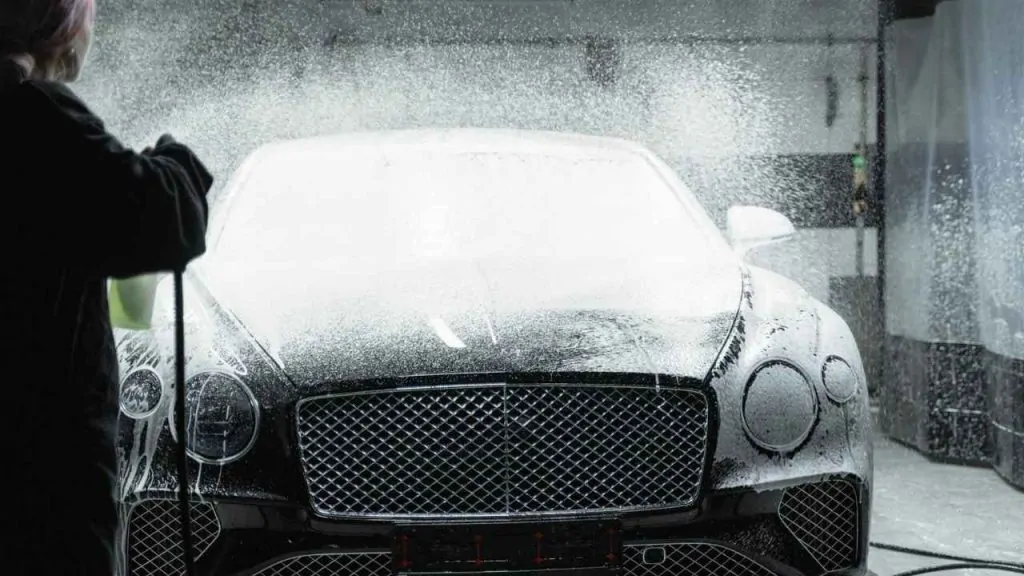
Exterior Detailing Process:
- Pre-Rinse: Start by rinsing the car with a hose or pressure washer to remove loose dirt. This step is crucial for preventing scratches during the wash.
- Foam Application: Using a foam cannon, apply a thick layer of foam across the car’s exterior. This softens dirt and grime, making it easier to wash away without harsh scrubbing.
- Two-Bucket Wash: Wash the car using the two-bucket method to reduce the chances of scratching. One bucket should contain soapy water and the other clean water for rinsing the mitt.
- Clay Bar Treatment: After washing, run your hand over the paint to feel for rough spots. Use a clay bar to remove embedded contaminants, which restores a smooth finish to the paint.
- Polishing: If there are swirl marks or fine scratches on the paint, use a polishing compound to buff them out. A dual-action polisher can speed up this process and provide professional-level results.
- Waxing or Sealing: Apply a wax or paint sealant to protect the car’s surface from UV rays, dirt, and water. Waxes provide a deep shine, while sealants offer longer-lasting protection.
- Wheel and Tire Detailing: Clean the wheels and tires with designated products, using brushes to get into tight areas. Apply tire dressing to make the tires look new.
- Fuel Door Area – Often overlooked, the inside of the fuel door can collect dirt and grime.
- Antenna Base – If your car has a traditional antenna, dirt can build up around its base.
- Windshield Wipers – Clean the blades and the area beneath them to avoid smearing on the windshield.
- Sunroof Seals – Dust and debris can accumulate in the seals of a sunroof, which can also lead to leaks if not maintained.
- Wheel Wells – Often overlooked, these areas collect mud, dirt, and debris and should be pressure washed for a complete clean.
- Underbody – The underbody of the car can accumulate salt, road grime, and debris that can lead to corrosion if not cleaned regularly.
- Window Seals and Trim – Clean around the rubber seals and window trim to remove built-up dirt and prevent leaks or wear.
- License Plate Area – The area behind and around the license plate can trap dirt and debris.
- Roof Racks – If your car has roof racks or crossbars, these need to be cleaned as they gather dust and pollutants.
Interior Detailing Process:
- Vacuuming: Begin by vacuuming the seats, carpets, and floor mats. Remove the mats and vacuum underneath to catch all dirt and debris.
- Upholstery Cleaning: If you have cloth seats, use a fabric cleaner to remove stains. For leather seats, clean them with a leather cleaner and conditioner to keep the material soft and crack-free.
- Dashboard and Console Cleaning: Use a microfiber cloth and a plastic protectant to clean the dashboard, center console, and door panels.
- Window and Glass Cleaning: Use an ammonia-free glass cleaner to clean the interior windows without leaving streaks. Make sure to also clean the rearview mirror and side mirrors.
- Odor Removal: If the car has persistent odors, use an odor neutralizer or air freshener to freshen up the interior.
- Seat Belts – These should be wiped down, as they collect body oils and dirt over time.
- Seat Tracks – Clean out any debris or dust that gets trapped in the seat adjustment tracks.
- Headrests – Often skipped, but they should be cleaned with the seats, especially in fabric interiors.
- Spare Tire Compartment – The trunk, especially the compartment for the spare tire, can gather dirt and moisture.
- Glove Compartment – Wipe down the inside of this storage area, which can collect dust over time.
- Under the Seats – Often a spot where food crumbs and dirt accumulate, and difficult to reach, but important to clean.
- Child Seat Latches/Anchors – These can collect dust and debris over time, especially if car seats are frequently installed and removed.
- Seat Pockets – Rear seat pockets on the back of the front seats are often neglected but should be cleaned out.
- Sun Visors – These are often touched and should be wiped down, especially the vanity mirrors if they’re present.
- Foot Pedals – Brake, clutch, and accelerator pedals can get dirty and slippery, so they should be wiped clean for safety.
- Ceiling/Headliner – Dust and stains can accumulate on the headliner over time, especially around areas where hands touch it, like near handles and sun visors.
Car Engine Bay Cleaning: A Step-by-Step Guide
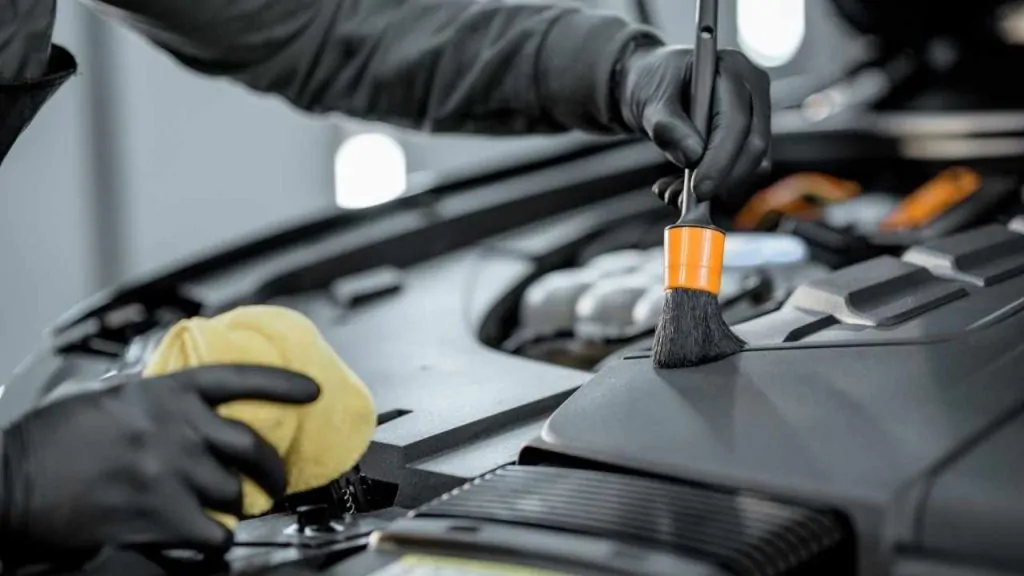
I. Introduction
- Importance of Engine Bay Cleaning:
- Improved engine performance
- Enhanced appearance
- Prevented corrosion and damage
- Safety Precautions:
- Wear protective gloves and eye protection
- Work in a well-ventilated area
- Avoid spraying water directly onto electrical components
II. Preparation
- Park Car on a Level Surface: Ensure the engine is cool to prevent burns.
- Gather Supplies:
- Engine degreaser
- All-purpose cleaner
- Microfiber cloths
- Brushes (soft-bristled)
- Vacuum cleaner
- Water hose
III. Cleaning Process
- Remove Excess Dirt and Debris: Use a leaf blower or vacuum to remove loose dirt and debris from the engine bay.
- Spray Engine Degreaser: Liberally apply engine degreaser to all surfaces of the engine bay, focusing on areas with heavy grease and grime.
- Allow Degreaser to Soak: Let the degreaser sit for the recommended time (usually 5-10 minutes) to penetrate and loosen grime.
- Scrub with Brushes: Use soft-bristled brushes to gently scrub away stubborn grime and grease. Avoid using harsh brushes that could damage delicate components.
- Rinse Thoroughly: Use a water hose to rinse away the degreaser and grime. Ensure all surfaces are clean and free of residue.
- Dry with Microfiber Cloths: Dry the engine bay thoroughly with microfiber cloths to prevent water spots and corrosion.
- Clean Plastic Components: Use an all-purpose cleaner and microfiber cloths to clean plastic components like air ducts and covers.
IV. Additional Tips
- Protect Sensitive Components: Cover electrical components with plastic bags or towels before spraying water to prevent damage.
- Avoid High-Pressure Cleaning: Excessive water pressure can damage electrical components.
- Use a Steam Cleaner (Optional): For a deeper clean, consider using a steam cleaner. However, be cautious to avoid damaging delicate components.
- Regular Maintenance: Clean the engine bay regularly to prevent buildup of grime and maintain optimal performance.
DIY Car Cleaning Tips for Home
Exterior Cleaning
- Find a Shaded Spot: Avoid direct sunlight to prevent the soap from drying too quickly and leaving water spots.
- Gather Supplies: You’ll need a bucket, wash mitts, microfiber towels, car wash soap, a pressure washer or hose, and a wheel brush.
- Two-Bucket Wash Method: Use two buckets: one for soapy water and one for clean rinse water to prevent dirt from being transferred back onto the paint.
- Start with Wheels: Clean the wheels and tires first to avoid getting brake dust on the rest of the car.
- Wash the Body: Use a wash mitt and soapy water to gently wash the body of the car. Rinse thoroughly with clean water.
- Dry the Car: Use a microfiber towel to dry the car immediately to prevent water spots.
Interior Cleaning
- Remove Trash and Debris: Start by removing any trash or debris from the interior.
- Vacuum Thoroughly: Vacuum the carpets, seats, and floor mats to remove dirt and dust.
- Clean Surfaces: Use a microfiber cloth and interior cleaner to clean the dashboard, door panels, and console.
- Clean Windows and Mirrors: Use a glass cleaner and microfiber cloth to clean the windows and mirrors.
- Deodorize: Place air fresheners or baking soda in the car to eliminate odors.
Additional Tips
- Use a Clay Bar: Remove embedded contaminants like tar and tree sap from the paint surface.
- Apply Wax or Sealant: Protect the paint from the elements by applying a coat of wax or sealant.
- Regular Maintenance: Clean your car regularly to prevent dirt and grime buildup.
- Avoid Harsh Chemicals: Use mild, pH-neutral car cleaning products.
- Wear Gloves: Protect your hands from harsh chemicals.
What Not to Do While Cleaning a Car
- Avoid Using Dish Soap: Dish soap is too harsh for car paint and will strip away any wax or protective coating. Always use car-specific soap for washing.
- Don’t Wash Under Direct Sunlight: Washing a car in direct sunlight causes the soap to dry too quickly, leaving water spots and streaks.
- Don’t Use the Same Cloth for Different Surfaces: Mixing up cloths can cause cross-contamination. Use separate microfiber cloths for cleaning windows, the dashboard, and the exterior to avoid spreading dirt and grease.
- Avoid Using a Single Bucket for Washing: Using one bucket increases the chance of reapplying dirt to the car’s surface. The two-bucket method helps keep the wash water clean.
- Don’t Scrub Paint Too Hard: Applying too much pressure while washing can cause scratches and swirl marks. Always be gentle when washing and drying the car.
Additional Tips for Car Detailing and Cleaning
- Regular Detailing Schedule: It’s recommended to detail your car every 3-6 months to maintain its appearance and protect its surfaces.
- Eco-Friendly Products: Consider using biodegradable, eco-friendly cleaning products to minimize environmental impact. Many brands now offer green alternatives that are effective yet gentle on the environment.
- Waterless Wash: For in-between washes, use a waterless wash spray. This is a quick way to clean your car without needing a full wash and is especially useful if you live in an area with water restrictions.
- Paint Protection Film (PPF) or Ceramic Coating: For long-term protection, consider applying a paint protection film or ceramic coating. These protect against chips, scratches, and environmental damage.
If you want to learn more about car cleaning and detailing, you can look more on our website fourwheelsdetail.com

Hi! I’m Harry, With over a decade of experience in car detailing and cleaning, I specialize in restoring vehicles to their pristine best. Passionate about sharing expert tips on fourwheelsdetail.com, I’m here to help readers maintain their cars’ beauty, from paint protection to tackling tough stains.
